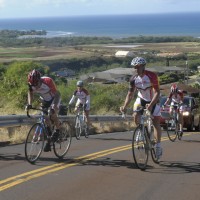I know that I promised on my last post that I would write about Power Zones this time, but without a firm grasp on the principle of Power to Weight ratio, and its impact on climbing power, the zones won’t make nearly as much sense as they should. Just measuring how many watts you can generate doesn’t give us much information without also knowing how much you weigh. Principally, this is because climbing ability is very dependent on the power-to-weight ratio of the rider, due to the gravitational forces that need to be overcome. The rider’s weight will increase the power required to climb the hill, and so power training is designed first and foremost to develop the requisite leg strength and the capability to climb with some semblance of speed (speed being a very relative word of course).
2014-01-29


While 1 Watt/Lb may not be relevant for the indoor cycling rider per se, making sure they know where their power is and improving that power may very well be relevant. I covered the reasons why in a previous post, specifically with a subsection titled: “I Don’t Ride Outside…Why Should I Care About Power?”
You can read that post here
The title of the article is somewhat misleading. I was hoping that the article would be more for the indoor cyclist as most of them are not outdoor riders. They are there for a good solid workout and will not be riding outdoors.
If the indoor bike is not calibrated correctly, then the information they are receiving is not accurate. This seems to be an ongoing problem with bikes that are moved for the class.
It would be helpful to have reasoning as to why this important for the indoor rider who only rides 45-60 minutes 2 – 3 days a week.
I guess the assumption is that the 70 year old will struggle to attain 1W/lb whereas the younger riders will not? While at face value that might seem logical, consider that the picture on this blog post was taken on the steepest and hardest climb I’ve done in my life where a woman at age 62 beat all the men much younger than her up that 1 hour grueling climb (except for Tom Scotto of course). The trip after that I had a 71 year old man also toast everyone half his age on another filming expedition. On the other end of the spectrum, I’ve ridden with young people (one gal who comes to mind was one of my favorite Spinning instructors when I first opened my studio) who struggled on climbs with very mild grades.
So first and foremost, age is no predictor of performance any more than heart rate is. Nevertheless, your point is well taken in that some will be able to achieve that level of power, and others won’t. It’s not meant to be a universal standard that everyone should be able to achieve. It’s meant to be a “sign post” as it were, or a marker by which you can build goals around.
If you do a 10 or 20 minute test in class and some can’t maintain 1W/lb, you have a very clear goal for them – especially if they want to ride in a hilly environment. If they don’t ever want to ride outside, or they only ride flat terrain anyway, this metric is almost meaningless.
For those who exceed it, it becomes a matter of how fast do they want to go (or how much less do they want to suffer). They can always do better. It WILL work as a litmus test for climbing outdoors, and for that it is very valuable for those training to ride hilly terrain, and I like to remind students of their personal goals when power training – it’s not meant to be some arbitrary number people must get to – it always must be defined in terms of one’s ability and goals.
I love the 1watt per pound concept! Simple to remember and communicate to students. But, how does age effect the output when your class may have a rider in his 70’s and others in their 20’s and 30’s?